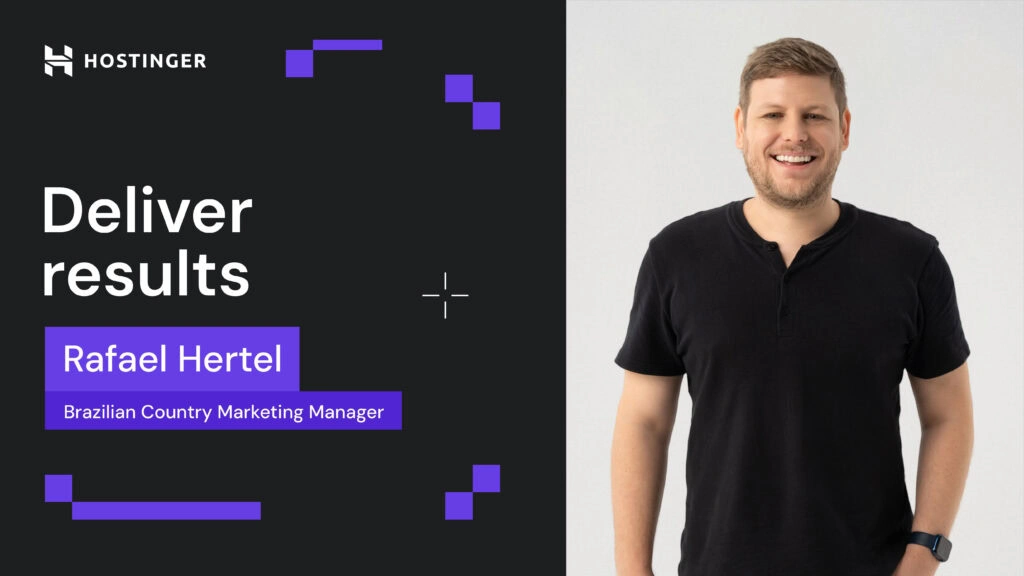The 3 Game-Changing Processes That Got Us Results Fast

At Hostinger our vision is to enable millions of people around the globe to unlock the power of the internet by giving them tools to learn, create, and grow online. We provide a world-class website hosting platform for over 1.2 million users worldwide. With such growth comes complexity.
Our once simple business now encompasses 40+ different websites, all powered by different technologies. That’s why our number one challenge is to align the team. Uniting a company towards one goal in a shifting and competitive landscape is no mean feat. Seeing the bigger picture has been absolutely crucial ever since our engineers had to divide their attention between several different projects running simultaneously. This has pushed us to explore new methods and tools which would allow us to increase our productivity and lead us to a more united team.
Key performance indicators (KPIs) were one of the first tools we applied. They are individually set for each team member. We structured departments based on their function (developers, system engineers, customer service, marketing) and fostered an open and transparent culture to ensure a clear vision of how the daily line of work contributes to the overall company goals. Results were moderate, so we continued in our search for game-changing strategies.
Last year, just as we were about to experience yet another growth phase, an ex-colleague introduced me to the second tool that we applied – OKRs (objectives and key results). I was instantly hooked and clearly saw that it is the way for us to go.
Now, as we have just finished our second set of quarterly OKRs and are over 8 months into the practice, we clearly see and can state the results and the positive results they have brought to our company. Combined OKRs and two other hyper-efficient practices have sky-rocketed our productivity.
Together, these are the 3 processes that have been game-changing:
- OKRs
- Cross-functional Agile team structure based on the product
- Biweekly sprints
1. OKRs
The single most important tool to increase our productivity was OKRs – a very simple, but extremely powerful way to set organizational goal.
OKRs have helped us stay focused on our company goals and reflect on each quarter’s progress. Some of the biggest tech companies in the world, such as Google, LinkedIn, and Zynga, use OKRs. The important thing here is that at least 70% of objectives and key results come from employees.
Breaking down OKRs
Objectives in OKRs are high importance, strategically measurable goals. When recognized and set apart, objectives become easily trackable units for which we are accountable.
Once we have identified our goals, the progress is quantified by applying numerically-based measures of success towards the goal at regular and defined intervals. They are known as key results.
Instead of involving the management in this process, only the team members working on an objective are responsible for the results.
There are no tasks or to-do lists, only an objective record of what a positive result looks like. This allows us to experiment and assess all possible scenarios when in the process of achieving targeted results.
Not only do we focus on the company’s OKRs, but we also set personal ones. This brings transparency for the entire team, making everyone aware of each other’s goals and expectations.
The use of personal OKRs goes beyond goal-setting and measuring. We’ve also discovered OKRs’ ability to provide clarity over team structure and validation for the company’s direction.
Reinforcing the Flat Structure in Our Organization
OKRs solve the challenges that arise due to the complexity of a large team in two ways:
1. They focus on every team member in the organization individually, therefore one’s contribution to the team is clear and concise.
2. By taking responsibility to achieve personal and company goals, one can identify when and where they are needed the most and contribute accordingly.
Validating the Company’s Direction
The more an objective is understood, the easier it is to define measurable results. A simple, easy, and clear process will lead to the desired outcome.
We have also discovered that hard-to-draft OKRs are a symptom of bigger problems.
2. Cross-Functional Agile Team Structure Based on the Product
After implementing OKRs, we noticed that it was almost impossible to craft functional OKRs for our developers and system engineers due to their daily tasks being diverse. That was a clear indication of a dysfunctional team structure.
Our solution was to introduce an Agile team structure. An Agile team is a cross-functional group of people that have everything and everyone necessary to produce a working, augmentative product. We borrowed ideas from the Agile methodology and created our own cross-functional teams based on the product.
As a result, we no longer have a team of developers or system engineers. Instead, we have teams with all the necessary people to complete the job internally. For instance, our marketing team has a team leader, a designer, content writers, a PPC specialist, and a developer. Teams are fast, efficient, and completely independent. Each has its own OKRs. In order to do its job, a team doesn’t need to ask for help from the developer team anymore.
This eliminates bureaucracy and having to wait for the other departments to complete their segment of the project. Each team is fully empowered to get the work done by itself.
3. Biweekly Sprints
We’ve implemented OKRs. We’ve organized talented Agile teams. Now we needed to increase our speed in delivering the change to our customers faster.
As Leonardo da Vinci once said: ‘I have been impressed with the urgency of doing. Knowing is not enough; we must apply. Being willing is not enough; we must do.’
To propel our OKRs, we needed to divide them into smaller chunks within set deadlines.
How would we do it, though? Deadlines never seemed to provide the desired result.
Yes, they can be energizing, sharpen our focus, set priorities, and make the collaboration between teams more effective. After all, when there is no pressure, the mind wanders and the brain looks for external stimulation. However, we noticed time and time again how a sense of urgency created by a deadline can backfire. Creating a sense of urgency takes a lot of effort, yet provides very few results.
Deadlines tend to exhaust team leaders and waste their focus. Micromanagement also reduces the trust between team leaders and their teams. Deadlines start to overtake the communication stream, leading to us questioning the priority instead of asking why. With too many deadlines, we stop thinking clearly and effectively and start to feel stressed and overthink.
Fear of underachievement and failure led us to the third process we adopted: self-implemented bi-weekly sprints. The principle here is that deadlines work far better when they are personally motivated.
When we set our own goals, the why becomes more powerful and the drive to achieve is stronger. As a result, our product teams set their deadlines in bi-weekly sprints. Every two weeks the teams come together, examine their quarterly OKRs, and plan their next sprint. Delivering on goals set individually drives team members to hold each other up, leading to increased happiness and engagement at work.
Final Words
All it took to grow and improve our complex beast was a vision, OKRs, and an Agile team structure with work in bi-weekly sprints. Responsibilities are now clear and shared, and we have a sharp, motivated team who are nailing it every day. This is simple but very powerful.
If you found this interesting, check out the following links to study the topic deeper:
- https://medium.com/startup-tools/okrs-5afdc298bc28#.xvs6876yb
- https://www.youtube.com/watch/?v=mJB83EZtAjc
- https://medium.com/@kimber_lockhart/don-t-create-a-sense-of-urgency-foster-a-sense-of-purpose-724e309ecdb0#.4jpp4ho3o
- https://www.fastcompany.com/3030567/work-smart/the-case-for-and-against-stressful-deadlines
- https://www.leadingagile.com/2015/02/what-is-an-agile-team-and-how-do-you-form-them/



Comments
November 18 2017
Awesome!